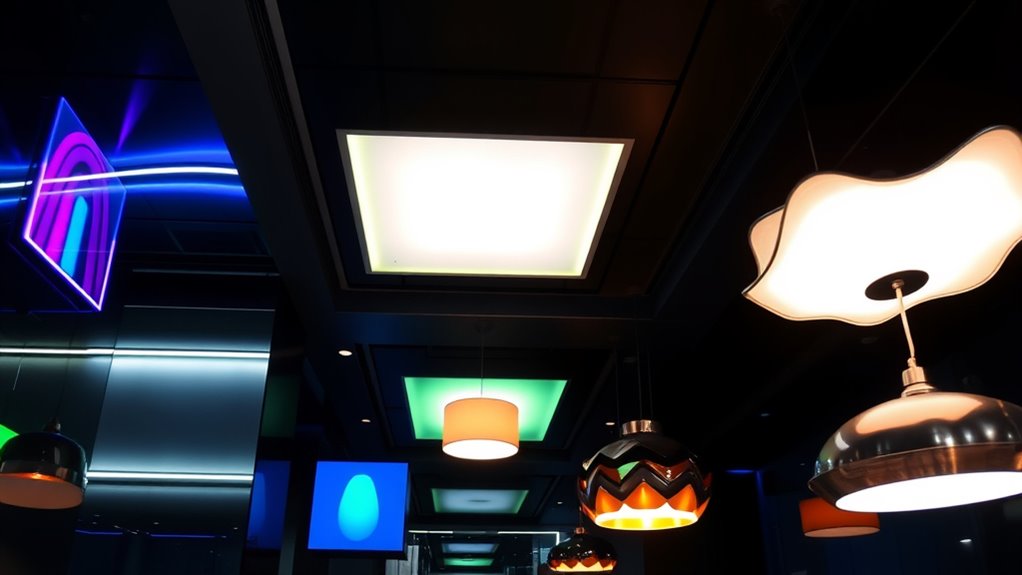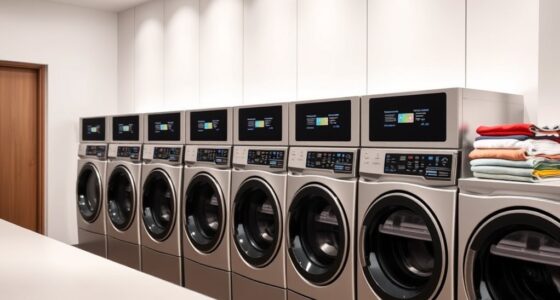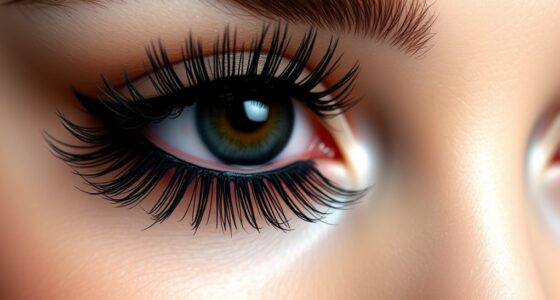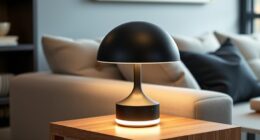Futuristic lighting trends focus on cutting-edge materials like OLEDs, nanostructured surfaces, and eco-friendly composites for sleek, seamless fixtures. Smart, wireless tech and AI enable effortless control, personalized scenes, and energy optimization. Minimalist designs emphasize hidden, geometric, or art-inspired forms that blend into modern spaces. Dynamic, mood-enhancing colors and biophilic elements create calming, natural environments. Sculptural and customizable pieces add unique character. Exploring these innovations reveals how lighting is transforming into functional art—stay tuned to see how these trends unfold.
Key Takeaways
- Integration of AI and IoT enables adaptive, personalized lighting that responds to user habits and environmental changes.
- Smart surfaces and self-healing coatings extend fixture lifespan while offering dynamic, interactive lighting experiences.
- Minimalist, seamless fixtures with hidden, art-inspired designs create unobtrusive, futuristic aesthetics.
- Biophilic and organic-inspired lighting incorporates natural elements and textures for calming, sustainable environments.
- Wireless control and scene customization facilitate effortless, remote management of complex, immersive lighting setups.
Innovative Use of Cutting-Edge Materials and Surfaces

The future of lighting design hinges on the innovative use of advanced materials and surfaces that push the boundaries of form and function. OLED panels enable ultra-thin, seamless fixtures with minimal visual impact, while smart surfaces dynamically respond to environmental changes. Nanostructured materials form light-diffusing surfaces that provide uniform, glare-free illumination and reduce energy use. Aerogel and fiberglass composites create lightweight, insulating fixtures, and flexible polymers allow for versatile, bendable designs. Self-healing coatings automatically repair scratches and minor damages, extending fixture lifespan. Reactive materials change color or texture based on user interaction or conditions, enhancing aesthetics and functionality. Embedded sensors integrated into these surfaces enable multifunctional lighting solutions that monitor environments or collect data seamlessly. Additionally, the use of cutting-edge materials allows for innovative customization and improved durability in lighting fixtures. Advances in material science continue to open new possibilities for designing adaptive and sustainable lighting solutions. Exploring smart surface technologies offers further potential for dynamic and interactive lighting environments, especially when combined with emotional support considerations to create comfortable, user-centric spaces. Incorporating vertical storage solutions can maximize space utilization in lighting design, especially in compact environments.
Integration of Smart and Wireless Technologies
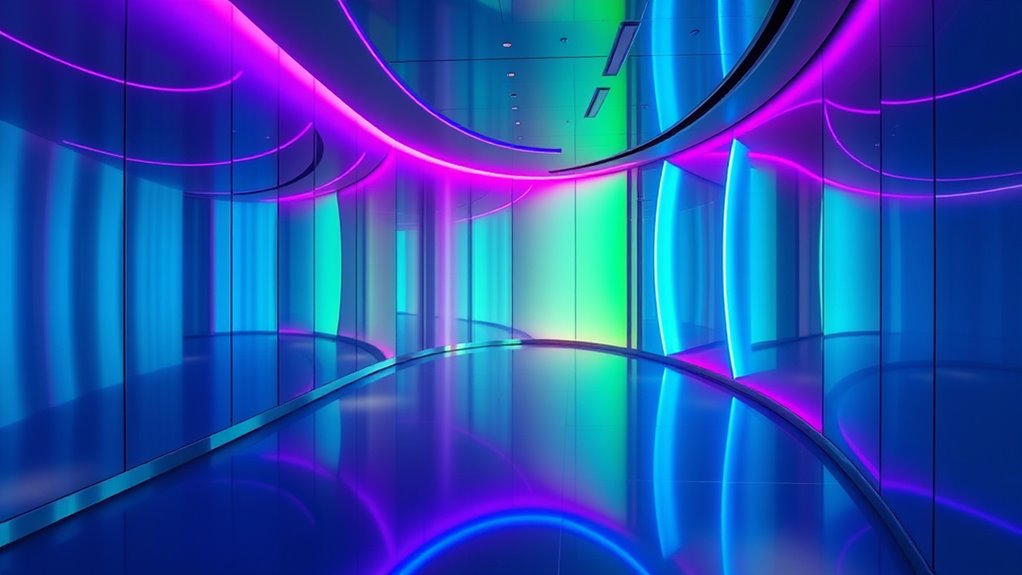
As smart and wireless technologies become integral to lighting design, you can effortlessly control and customize your lighting environment through Wi-Fi, Bluetooth, or Zigbee protocols. Smart lighting systems enable wireless integration, allowing connected fixtures to be easily installed or repositioned without complex wiring, boosting flexibility. With advanced lighting control features like adjustable color temperature, dimming, and scene setting, you can create a personalized ambiance that suits your mood or activity. AI sensors and smart technology further enhance automation by adjusting lighting based on occupancy or natural light levels, optimizing energy efficiency. Remote control via smartphones or voice assistants makes managing your lighting simple and intuitive. Overall, smart lighting’s seamless integration improves convenience, sustainability, and the ability to craft tailored environments effortlessly.
Emphasis on Minimalist and Seamless Design
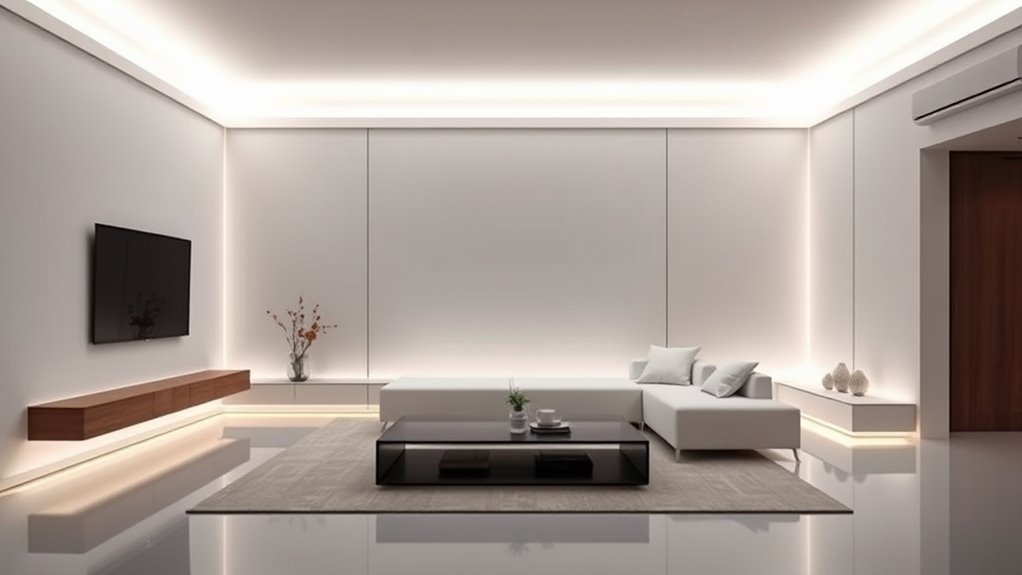
Minimalist lighting design focuses on creating a sleek, unobtrusive look that seamlessly integrates with modern interiors. By emphasizing clean lines, neutral tones, and sleek finishes, you achieve a harmonious space. Hidden fixtures like LED strips and flush mounts blend into architectural elements, reducing visual clutter. Smart lighting systems allow you to control brightness and color temperature remotely, enhancing functionality without visible switches. Geometric shapes and monochromatic schemes further streamline the aesthetic, emphasizing simplicity and elegance. Seamless design solutions prioritize functionality and subtlety, often featuring fixtures that complement architectural features. Additionally, understanding the signs of spoilage of lighting fixtures can help maintain a futuristic, sophisticated vibe, ensuring your space remains both stylish and safe.
Dynamic Color-Changing and Mood-Enhancing Fixtures

Imagine transforming your space instantly with color-changing fixtures that adapt to your mood or activity. You can control lighting remotely or let sensors automatically adjust hues based on the time or environment. These personalized lighting experiences not only set the tone but also boost your well-being through tailored ambiance. Incorporating natural materials in your fixtures can further enhance the calming effect of the lighting and create a more authentic, cozy atmosphere. Additionally, integrating smart lighting technology can make these adjustments seamless and more intuitive for users. Embracing energy-efficient options ensures that these innovative lighting solutions are sustainable and cost-effective over time. Understanding Merkle trees can also inspire creative lighting displays that complement dynamic visual narratives.
Adaptive Lighting Experiences
Adaptive lighting experiences leverage smart fixtures with color-changing LEDs that you can control through apps or voice commands, allowing you to customize the ambiance for different moods and activities. These fixtures automatically adjust color temperature and brightness based on time or preferences, enhancing comfort and circadian rhythm regulation. With occupancy sensors and ambient light detection, dynamic fixtures optimize lighting and energy efficiency in real-time. Advanced systems seamlessly integrate with home automation platforms, enabling you to create various scenes for entertainment, relaxation, or productivity. Incorporating energy-efficient features ensures sustainable lighting solutions that reduce electricity consumption and environmental impact. Additionally, the integration of personalization tools allows users to tailor lighting settings to their specific lifestyle needs, further enhancing the user experience. Recognizing angel number patterns in your environment can also inspire personalized lighting setups aligned with your spiritual or emotional goals. Understanding entertainment and parks can help in designing immersive lighting experiences for themed environments and attractions. Moreover, smart home integration enhances the overall user experience by enabling centralized control and automation of lighting across different areas.
Personalized Ambiance Control
Personalized ambiance control has become increasingly sophisticated thanks to dynamic color-changing fixtures that let you customize your lighting with just a smartphone app or voice command. These LED color-changing fixtures enhance mood lighting by offering adjustable color temperatures and hues that support your circadian rhythm, promoting better sleep and well-being. Integrated with advanced ambiance control systems and smart home platforms, you can create lighting scenes tailored to different activities or times of day. Voice control makes adjusting settings effortless, whether you want a relaxing atmosphere or energizing light. With personalized lighting options, you can set preset modes for focus, relaxation, or vitality, making your home more comfortable and health-conscious. Additionally, many of these systems are compatible with aroma diffuser technology, allowing you to synchronize lighting with your favorite scents for a truly immersive environment. This seamless integration elevates your environment and overall mood, especially as automation and smart home technology continue to evolve. Emerging trends also include user customization features that adapt lighting based on your habits and preferences, leveraging artificial intelligence to optimize your lighting experience.
Biophilic and Nature-Inspired Lighting Concepts

You can incorporate natural elements like leaves, branches, and water-inspired shapes to create calming, nature-connected spaces. Using organic curves and materials such as wood and stone enhances warmth and authenticity in your lighting. These designs strengthen the indoor-outdoor connection and promote a sense of well-being through natural, diffused illumination. Incorporating principles of ethical hacking can also inform security aspects of smart lighting systems to protect your designs from cyber threats. Integrating beach-inspired aesthetics can further evoke tranquility and relaxation in your lighting schemes. Additionally, understanding somatic therapy principles can inspire designs that foster physical comfort and emotional well-being within these spaces.
Natural Element Integration
Natural element integration in lighting design brings the calming beauty of the outdoors inside by incorporating natural motifs such as leaves, water patterns, and organic shapes. You’ll find biophilic lighting using natural materials like wood, stone, and recycled glass to create authentic, sustainable fixtures. These incorporate flowing lines, organic shapes, and textures that mimic natural forms like pebbles, trees, or floral patterns. This approach enhances holistic wellness by reducing stress and fostering a strong connection with nature. To deepen your understanding, consider these aspects:
- Water motifs and natural pattern lighting
- Plant-inspired design for tranquility
- Eco-friendly fixtures promoting sustainability
- Organic textures supporting holistic wellness
Organic Shapes and Curves
Building on the integration of natural elements, organic shapes and curves bring a fluid, harmonious quality to lighting design that echoes nature’s effortless forms. These nature-inspired lighting fixtures, featuring fluid silhouettes and asymmetrical designs, enhance biophilic design by mimicking natural forms like leaves, water, and rocks. Materials such as rattan, wood, and textured ceramics reinforce the tactile connection to nature while supporting sustainable lighting practices. Curved fixtures, like pebble-shaped chandeliers or leaf-inspired pendants, evoke movement and spontaneity, promoting well-being and reducing stress. Incorporating eco-conscious materials and natural forms creates a calming environment that aligns with wellness and sustainability goals.
| Shape | Material | Inspiration |
|---|---|---|
| Pebble | Ceramics | Water, stones |
| Leaf | Wood, rattan | Plants, foliage |
| Water ripple | Textured glass | Water flow |
| Asymmetrical curves | Reclaimed wood | Organic flow |
| Organic silhouettes | Sustainable composites | Nature-inspired |
Indoor-Outdoor Connection
Integrating outdoor-inspired lighting elements creates a seamless connection between indoor and outdoor spaces, enhancing biophilic lighting. By using natural-inspired fixtures that mimic outdoor patterns like dappled sunlight or leaf motifs, you strengthen the indoor-outdoor connection. Incorporate organic shapes and natural materials such as wood, rattan, and stone to foster warmth and authenticity. Water features and greenery integration with ambient lighting help create calming atmospheres that support holistic wellness. These design strategies promote outdoor-inspired design within urban interiors, reducing stress and encouraging relaxation. To deepen this connection, consider:
- Using diffused or shaded lighting mimicking outdoor conditions
- Incorporating water features with complementary lighting
- Adding greenery integration through plant-inspired fixtures
- Choosing natural materials for a warm, authentic feel
Sculptural and Art-Inspired Illumination Installations
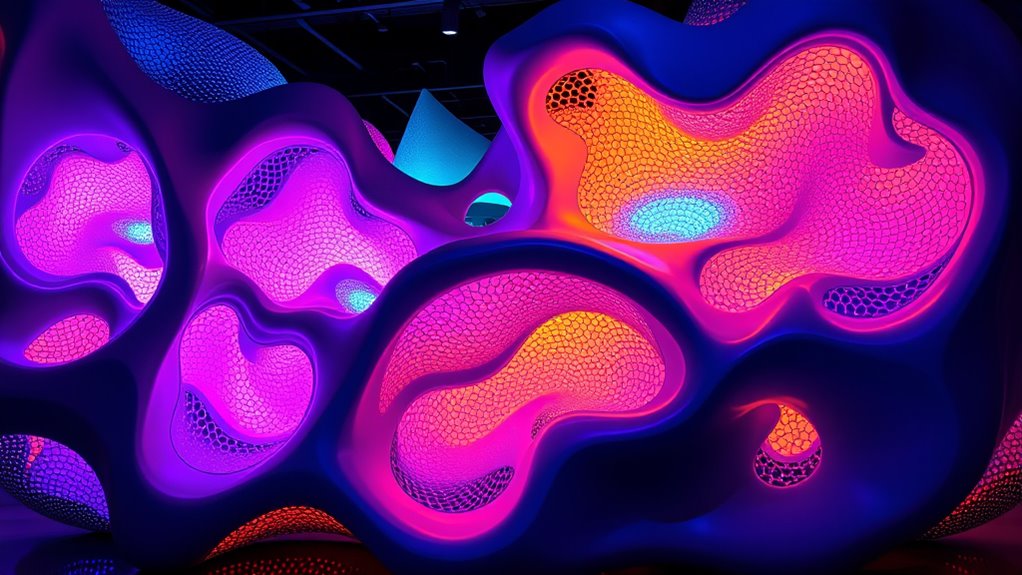
Have you noticed how sculptural and art-inspired lighting installations in 2025 are transforming spaces into immersive art experiences? These fixtures blend sculptural lighting and statement art pieces, becoming focal points that elevate interior design. Designers favor organic forms inspired by nature—water, mountains, flowing lines—creating dynamic fixtures that feel alive. Unconventional materials like textured ceramics, metal, and recycled glass add tactile appeal and sustainability. Many installations incorporate smart technology, allowing you to adjust color, intensity, and patterns, enhancing the immersive lighting effect. These art-inspired fixtures fuse artistic design with futuristic illumination, turning lighting into a form of expression. As a result, spaces become galleries where form and function coexist, making every room a riveting, immersive environment.
Customizable and Personalised Lighting Solutions
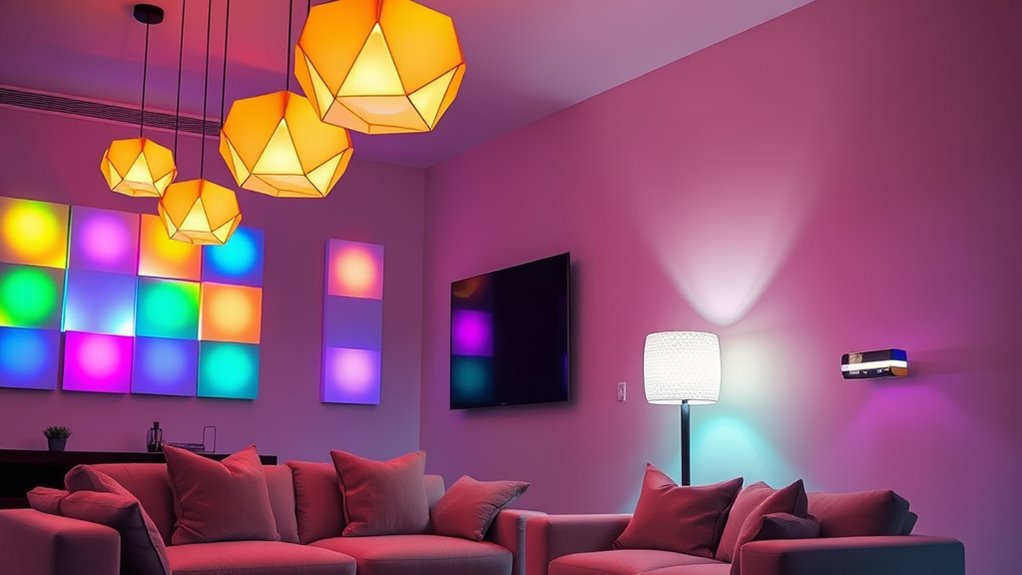
As technology advances, customizable and personalized lighting solutions are becoming more accessible and versatile, allowing you to craft unique atmospheres that reflect your style. Modular fixtures let you select shapes, colors, and materials for tailored aesthetics, while smart lighting systems enable ambiance control via smartphone apps or voice commands. Many brands offer custom shades and fixtures, letting you choose patterns, textures, and finishes that match your interior theme. Programmable LED technology adds dynamic effects like fading, color cycling, or scene presets, all adjustable to your mood. DIY lighting and artisan collaborations turn fixtures into statement pieces that showcase your personality. Whether you’re designing a cozy nook or a bold focal point, lighting customization empowers you to create truly personalized environments.
Frequently Asked Questions
What Are the Latest Trends in Lighting?
You’re seeing the latest lighting trends focusing on smart technology, so you can control your lights remotely or automate settings easily. Bold, sculptural designs made from innovative materials are also popular, giving your space a futuristic vibe. Energy-efficient LEDs inspired by natural forms blend style and sustainability. Plus, multi-functional fixtures with built-in features like wireless charging and Bluetooth keep your space modern and convenient. Sleek, hidden lighting solutions continue to create clean, minimalist aesthetics.
What Lighting Is in Style for 2025?
You might notice that in 2025, lighting becomes more than just functional — it’s about making a statement. Sculptural fixtures, like asymmetrical chandeliers and organic shapes, catch your eye and serve as focal points. Smart tech, such as voice control and wireless charging, seamlessly blends into your space. Natural-inspired designs and minimalist solutions also shine, offering energy efficiency without sacrificing style. It’s a year where form and function beautifully collide.
What Is the Future of the Lighting Industry?
You’re curious about where the lighting industry is headed, and it’s exciting. The future focuses on smart, connected systems that give you effortless control and personalization. Expect more energy-efficient options like OLED and micro-LEDs for sustainability. Natural-inspired designs will enhance wellness, while artisanal craftsmanship and eco-friendly materials will let you choose unique, sustainable fixtures. Overall, the industry aims to blend innovation with eco-consciousness, creating lighting solutions that are both functional and beautiful.
What Is the Trend in Lampshades in 2025?
Imagine walking into a room where lampshades are true works of art, sculptural and bold, catching your eye instantly. In 2025, you’ll see these statement pieces crafted with textured fabrics like silk and linen, offering soft, diffused light. Customization is key—think geometric and organic shapes blending seamlessly, with smart fabrics that change color at your command. These innovative designs turn lighting into a personalized, futuristic expression of style.
Conclusion
So, while these futuristic lighting trends promise a world of innovation and personalization, don’t forget to enjoy the simple glow of a cozy lamp or the warm light of a sunset. After all, no matter how smart or sculptural your fixtures become, sometimes the best illumination is still just a moment of natural light. Ironically, in a quest for the future, we might just find the most meaningful lighting in the most timeless of sources.
